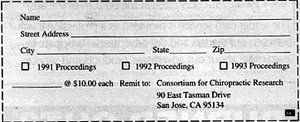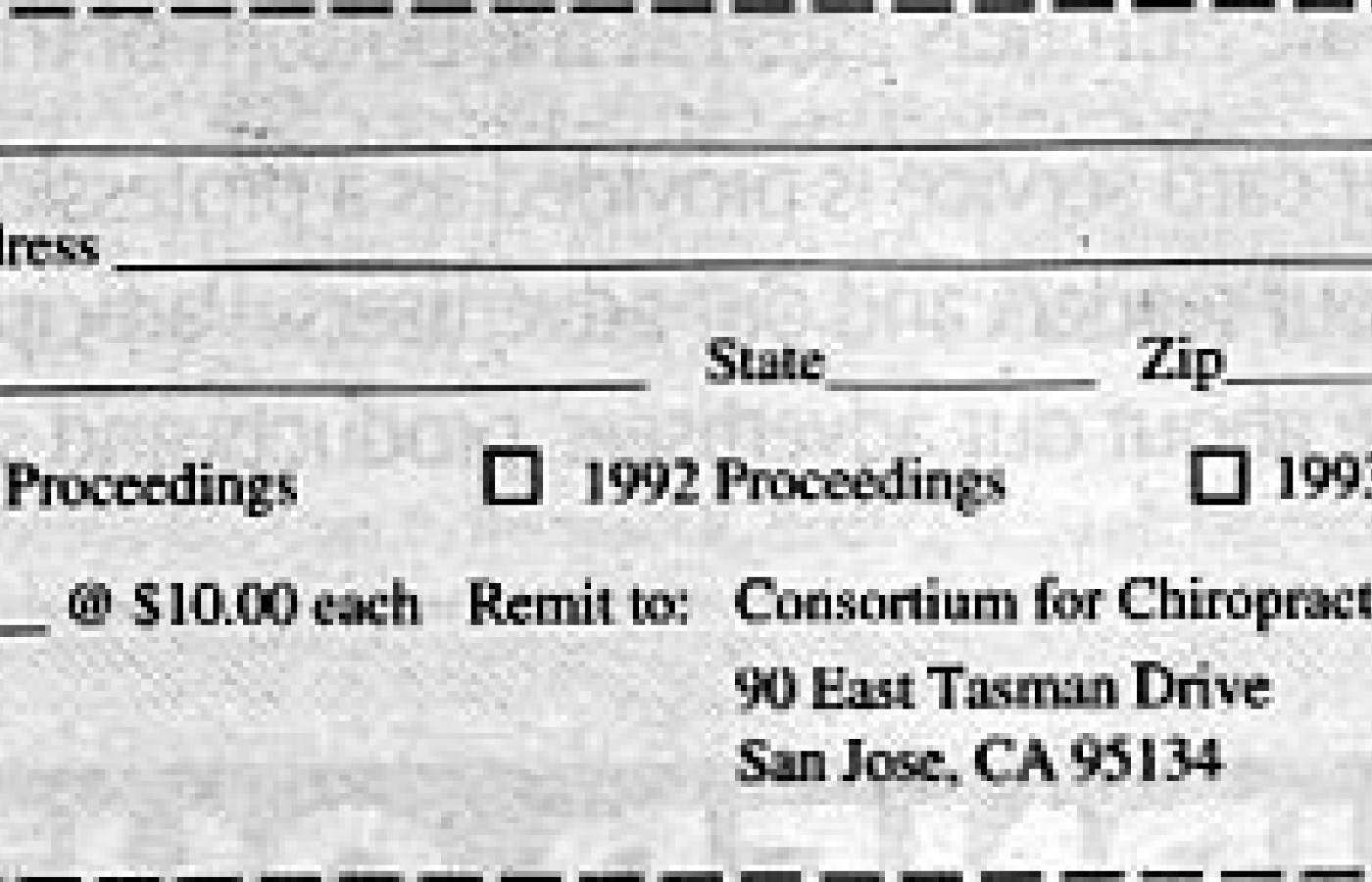It is estimated that 61% of patients with CTS avoid taking surgical options due to postoperative complications and costly surgical procedures. Chiropractic care offers a comprehensive and effective treatment for carpal tunnel syndrome, addressing the condition from multiple angles. Recent studies also have unveiled a game-changing adjunct to chiropractic treatments for CTS: nerve flossing.
Consortium Convenes 8th Annual CORE Conference
SAN JOSE, Calif. -- The Monterey Convention Center in beautiful Monterey, California was the venue for the 8th annual Conference on Research and Education (CORE) during the weekend of June 18-20. The 1993 edition of the Consortium for Chiropractic Research's annual showcase for science and professional dialogue was part of the annual convention of the California Chiropractic Association.
This year's CORE was carefully designed to perpetuate the Consortium's mission to study chiropractic procedures and technology, keep in touch with health policy issues, present practical research workshops, and display reports of recent science. Many of those in attendance hailed this year's program as the "CCR's best one yet." It not only serves as a means to expose chiropractors, chiropractic educators, and researchers to these important programs, but it is also an opportunity for nonchiropractic interest groups to get a look at our profession. The CORE program was observed by representatives of the insurance industry and a federal health care agency.
We are in the midst of witnessing significant changes in attitude about the chiropractic profession by health policy people. It is likely that the shifts in attitudes and the favorable change in the position of chiropractic in health care comes about not just because of "research data" or keen public relations, but more importantly because the world now sees the chiropractic profession critically appraising itself, allowing established "processes of accountability" to be applied to our science and art. These processes are what the Consortium for Chiropractic Research endorsed and embraced nearly four years ago when they began hosting "consensus conferences" to evaluate diagnostic and therapeutic chiropractic procedures.
This year the CORE featured procedure panels on surface electrode EMG and videofluoroscopy. Typical of past procedure panels, these included detailed literature reviews, solicited opinions of five recognized experts, and a summary statement from a selected discussant. The literature reviews and expanded abstracts of the panel experts are memorialized in the conference proceedings.
The literature reviews for surface EMG and videofluoroscopy are very well-written and have been submitted for publication in an indexed and peer reviewed journal (Journal of Manipulative and Physiological Therapeutics). The summary statements of the panel discussants will be submitted to the Journal of Chiropractic Technique for publication later this year.
The procedure panel on surface electrode EMG included invited experts: William Cockburn, DC; Robert Leach, DC; David Marcarian, MS; and John Triano, MA, DC. Regretfully, Drs. Christopher Kent and James Wood were invited but unable to attend. The literature review was presented by John Meyer, MS, DC; and Charles Lantz, PhD, DC, served as panel discussant.
The procedure panel on videofluoroscopy was attended by invited experts: James Antos, DC; Alan Breen, DC, PhD; Kevin Robinson, DC; and Harry Wallace, DC. Unfortunately, Dr. Vernon Pierce was invited but unable to attend. The literature review was presented by Gary Schultz, DC, DACBR; and Dr. Silvano Mior served as panel discussant.
Both panels produced probing discourse on the utility, effectiveness, and applicability of these diagnostic procedures and devices. Chiropractors that utilize these technologies in their practice or contemplating same, should obtain a copy of the 1993 CORE Proceedings and review the contributed papers on these topics.
This year's CORE also featured invited panels that discussed two timely topics: "Impact of Guidelines on Health Policy", and "Future Trends in Chiropractic Research." The first panel consisted of chiropractic representatives from major health policy projects sponsored by the Agency for Health Care Policy and Research (AHCPR), and the RAND Corporation. Dr. John Triano is one of the chiropractic representatives to the AHCPR interdisciplinary panel that is currently developing guidelines for the management of back pain. Dr. Reed Phillips serves as a technical advisor to the very active and prolific Back Pain Outcome Assessment Team (AHCPR), investigating diagnostic and management options for low back pain; and Dr. Alan Adams serves as a primary team member of the RAND appropriateness study on spinal manipulation for low back pain. Each of these DCs also served on the initial steering committee leading to the development of the Mercy Guidelines.
Joining these distinguished chiropractors on the panel was Dr. David Lanier, senior analyst for the Agency for Health Care Policy and Research, and agency liaison for the guideline panel on back pain. This panel was moderated by Dr. Jerilyn Kaibel, yet another appointee to a prestigious federal-level committee concerning the future of health care policy. Each panelist reflected how each of them have witnessed favorable change in perceptions and attitudes toward chiropractic in their respective interdisciplinary assignments. They all credited this progress to the profession's recent advances in critical investigation through good science; and, just as importantly, the chiropractic profession has shown that it can be critical of itself by producing an authoritative inventory of chiropractic practice (e.g., the Mercy Guidelines).
The panel discussing the future of chiropractic research featured leaders in chiropractic research from five institutions representing three countries. The summary of comments from this panel will be featured in an upcoming DC article.
Probably the best attended and most interactive session was the workshop on "Critical Appraisal in Chiropractic Practice" featuring Drs. Marion McGregor, Silvano Mior, and John Triano. A step-by-step instruction on how to assess the good journal articles from the bad ones, and good science from bad was presented. The educational format of this workshop had course participants using sample journal articles to apply what they learned to properly appraise the literature.
One of the more popular parts of the CORE Conference and the CCA Convention was the display of chiropractic science with the use of poster presentations. The quality of the science presented this year was exceptional, and all contributors are to be congratulated for their efforts. Especially commendable are the seven award-winning posters listed below. These authors received special cash awards of $250 or $500 as the result of scoring by a panel of selected judges. Special recognition and thanks is given to the companies and organizations that donated these cash awards: Dynamic Chiropractic, OUM & Associates, National Chiropractic Mutual Insurance Company, Journal of Chiropractic Technique, Journal of Manipulative and Physiological Therapeutics, Leander Technologies, and Foot Levelers, Inc.
1993 Core Scientific Poster Award Winners
"Intersegmental laxity in lumbar spine flexion: a digital videofluoroscopic study"-- Donna Mannello, DC, Logan College of Chiropractic
"Inter-rater agreement of basic technique radiographic analysis"-- Andrei Pikalov, PhD, Cleveland College of Chiropractic-Kansas City
"Use of spinal manipulative therapy (SMT) in treatment of duodenal ulcer"-- Kay F. Quam, EdD, and Marion McGregor, DC, MSc, National College of Chiropractic
"If I only could choose: Correlating student choice of three teaching styles with preferred learning style"-- John A.M. Taylor, DC, DACBR; Paul Clopton, MS; Enrique Bosch, MD; Kathryn A. Miller, DC; Stefaan Mercelis, MD, University of California, San Diego Medical Center
"Interpretation of abnormal lumbosacral spine radiographs: A comparison of students, clinicians, radiology residents, and radiologists in medicine and chiropractic"-- John A.M. Taylor, DC, DACBR; Stefaan Mercelis, MD; Fernando C. Seragini, MD; Guo-Shu Huang, MD; Yang-Hee Park, MD; Donald Resnick, MD, University of California, San Diego Medical Center
"Re-evaluation of oblique radiography of the cervical spine: comparison of 45 degree and 55 degree anteroposterior oblique projections"-- John J. Triano, MA, DC; Marion McGregor, DC, MSc; Maria Hondras, DC; Patricia C. Brennan, PhD, National College of Chiropractic
"A randomized controlled clinical trial of manipulation for chronic low back pain patients"CORE Proceedings Available
The Consortium for Chiropractic Research is responsible for presentation of the annual Conference on Research and Education (CORE) which is held in conjunction with the California Chiropractic Foundation's annual meeting. Many important issues are discussed and presented at the conference. The program includes consensus panels, procedure panels, presentation of papers and poster sessions. All of this information is put together in a comprehensive, fully bound proceedings and is available to the general public through the Consortium for Chiropractic Research. The Consortium currently has volumes from 1991,1992, and 1993.
1991 CORE, Monterey, California, includes papers on static cervical x-ray analysis, leg length insufficiency lumbar palpation, skin temperature assessment short lever specific contact procedures, and others.
1992 CORE, Palm Springs, California, includes such topics on leg length insufficiency, specific contact adjusting, full spine x-ray, and managed care.
1993 CORE, Monterey, California, includes papers on surface electrode EMG, lumbar spine videofluoroscopy/cervical spine impact of guidelines on health policy future trends in chiropractic research critical appraisal in chiropractic practice, and over 35 poster abstracts on various subjects.
To receive your copy of these proceedings, a payment of $10 for each copy should be sent by check or money order (please see coupon). If you have any questions about the proceedings or any other information regarding the CORE or the Consortium, please contact Ms. Seva Craven, assistant executive director, at (408) 944-6066.
Daniel T. Hansen, DC, FICC
Olympia, Washington




